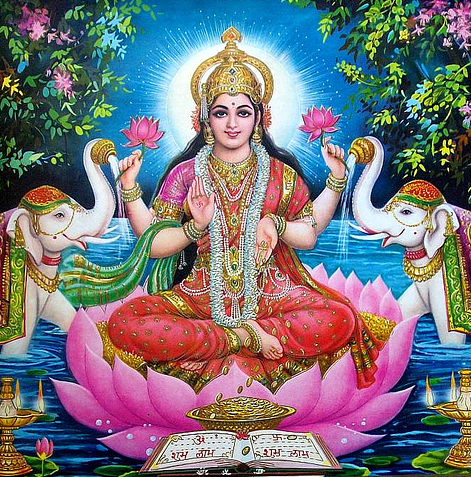S
Subhash Kak
Guest

Lakshmi
The chimpanzee and the human have similar sensory capacities, but why can some humans do science or poetry and chimps apparently can’t?
If truth be told, the memory of chimps is far superior to that of humans as revealed in the famous study on a chimpanzee named Ayumu at the Primate Research Institute of Kyoto University the details of which may be read here. [1][2] But the superiority of the chimp speed is not the issue as far as the capacity of the sense of sight is concerned, so let us put them as being effectively equivalent.
Our senses provide data to the brain; the understanding is not done by it, but by the mind.
The mind is not in the brain.
The mind operates at a plane that is not physical.
The chimp’s mind-plane is not identical to the human’s, even with the brain’s processing of imaging information is superior (or let’s say comparable) to the human’s.
One may infer from this that there are multiple mind-planes. In Sanskrit they are called lokas (cognate with”look”, that is “to see”), or worlds.
The mind-planes by themselves, if they were part of the brain’s circuitry, could not have the capacity to cognize. The only logical inference is that these planes exist in the realm of consciousness.
Consciousness is the light (Skt. div) that is scattered in our mind into a spectrum of hues, where each represents a different plane of cognition.
Reality may be seen through three planes: sat (universe and its laws), cit (consciousness), and ānanda (our ability to transform and intuit this reality). [3]
The divinities of these planes are called Vishnu, Shiva, and Shakti in the Indian tradition.
The power that makes this understanding accessible to the human mind is the Devi (Shakti). Since this light may be visualized variously by the mind, the one Devi takes many forms.
The confusion about the multiplicity of Devis comes from the view that “reality is just bodies”. This restricting and false view produces mindblindness, which is the inability to attribute mental states to others, or have empathy.
Historically, such mindblindness has been common in some cultures and in societies that objectify people, and especially women. Violence and rapine are a consequence.
Colonialism was driven by racism, in which the objectification was of the colonized people.
New woke ideas in the West are pushing for the objectification of everyone and of oneself. Surely, no good will come out of that.
The Planes of Consciousness
Of the multiple planes of consciousness, humans share many with animals. Indeed, our normal existence converges with that of animals. [4]
The three principal higher planes are:
The plane of empathic self. It is through this that one is able to acquire knowledge.
The plane of auspiciousness. It is through this that one is able to reach success.
The plane of power. This gives one the courage to take on challenges.
The Devis associated with these planes are Sarasvati, Lakshmi, and Durgā.
Let us look around the world to see the names for the Devi:
Greece: Aphrodite, Athena, Artemis
Rome: Minerva, Venus, Diana
Arabia: al-Lat, al-‘Uzzá, and Manāt
Japan: Benzaiten, Kishijoten, Koti-sri
If God is the Source of the inner light, one cannot reach it, for our minds are not made of the light. The illumination is the meeting of sat and cit, and the intuition arising is the power of the Devi.
Spiritual, scientific, or creative advancement only occur by the grace of the Devi.
Creative people often acknowledge that their ideas came spontaneously or in a dream, or suddenly in some strange manner.
Sometimes, the creative effort comes from the altering of the way one sees things. That is the counterintuitive working of the Devi, for it is like pulling oneself up by one’s own bootstraps.
On beauty and love
The Goddess is shown as beautiful and powerful, sometimes with a lion. [5] In the Ṛgveda 10.125 (Devīsūkta), the Goddess proclaims that she is the sovereign queen of all existence, and the ultimate object of all worship.
She rules the mind: our cognitions are a consequence of how the light falling on it is perceived.
Love is the emotion that gives meaning to life. Underneath this emotion is the attraction to beauty.
This attraction resides within the plane of our experience, but its source lies outside.
The two cannot be brought together: the attainment of the object of love ultimately turns out to be unsatisfactory.
It is “beauty” in itself, and not the association with the object of desire that holds the power. The beauty is not gendered, as the simplistic body-centric explanation would let one think; it resides in another plane.
Let us say the object of love is the Moon, and it is alone. The heart of the one who is in love is the heaving pond.
Autumn Moon शरद चान्द
alone; अकेला;
heaving pond काम्पता सरस
The Moon doesn’t know that it is beautiful. Beauty is solitary.
This lesson became a part of the ritual of the Vedic wedding (RV 10.85).
The bride is in gold and the groom in white. The bride is Sūryā (daughter of Sun, gold) and the groom is Soma (Moon, silver, white).
Light comes from the Sun. The bride herself may not know it, but her beauty becomes the teacher to the groom.
References
1. Ayumu the chimpanzee: https://www.pri.kyoto-u.ac.jp/sections/langint/ai/en/friends/ayumu.html
2. Matsuzawa, T. The Ai project: historical and ecological contexts. Anim Cogn 6, 199–211 (2003). https://doi.org/10.1007/s10071-003-0199-2
3. A brief guide to Hinduism for the perplexed.
4. The power of the story.
5. Nanā Devi Ambā and the Zodiac. https://www.academia.edu/51211754/Nanā_Devi_Ambā_and_the_Zodiac
Continue reading...
